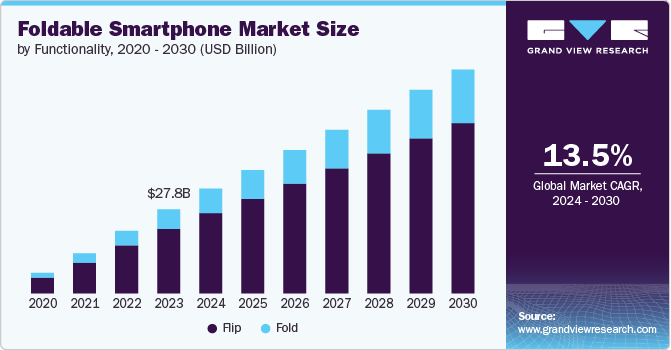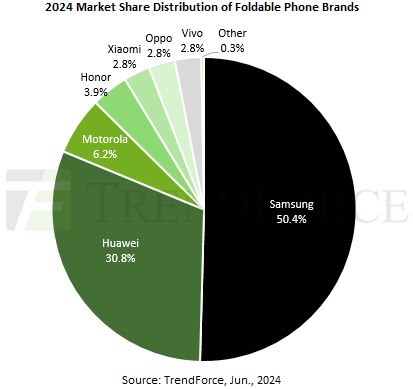That means only three million Z Flip 7 units and two million Z Fold 7 units are set to roll off the assembly line. For a company this big, those numbers don’t seem all that high. So, why the cutback? What is going on here?
Are foldable phones still not quite pulling in the masses?
Despite predictions that the foldable market will grow in the next few years, foldable phones are still pretty niche products. In fact, last year, foldables accounted for just 1.5% of the entire smartphone market. That is a small slice of the pie, especially when you consider how much attention foldables get in the tech world.

Foldable phones market is expected to grow.
So, yeah, hearing that Samsung is scaling back production might sound a little concerning at first. But honestly, it is probably a smart move. It is better for Samsung to cut back on units now than to overproduce and end up with unsold stock – something that might have happened with previous releases.
After all, Samsung still leads the pack with its Galaxy Z series. But competition is getting tougher as more brands enter the foldable game. I mean, just look at Oppo’s latest Find N5! It’s sleek, powerful and a solid competitor to the Galaxy Z Fold 6.


Samsung is still holding the top spot, but other brands are starting to catch up and make some serious moves.
In general, though, foldables are still niche products with hefty price tags – especially the book-style models. It is not like people are upgrading their foldables every year or rushing to drop thousands on a phone that, let’s face it, still has reliability issues like visible display creases or hinge problems. It’s going to take some time for these devices to shed that reputation.
Now, if prices drop, foldables could become a lot more appealing to the average consumer. Personally, I’m all in on flip-style foldables. They are compact, sleek and give me major nostalgic vibes of phones like the Motorola Razr V3 (the new Razr (2025) looks incredible, by the way). And this brings me to my next point, why I think Samsung is cutting back on its foldable production.
Apple to enter the game soon?


Concept image of a foldable iPhone. | Image credit – Apple Insider
Wonder how my previous babble led to this one? Well, as much as I love the Razr (2025) and the Galaxy Z Flip 6, they just don’t work for me since I’m fully in the Apple ecosystem. So, I keep waiting for Apple to join the foldable game. And let’s be real, it’s been a long wait. And from the looks of things, it is going to be even longer before we see a flip-style iPhone.
The book-style foldable iPhone, though, is rumored to hit as soon as 2027 (though, is that soon enough?). And Apple entering the foldable market could shake things up big time. I’m sure there are tons of iOS users who’ve been dying to try a foldable but haven’t made the jump to Android yet.So, before that happens, Samsung has some time to slow down, reassess and come back stronger. Let’s be honest, the jump from the fifth to sixth generation Galaxy Z Fold wasn’t exactly groundbreaking and it seems like the seventh generation might be more of the same with only minor upgrades. That could be part of the reason behind the lower production numbers – less need to ramp up units if there isn’t a major leap in features.
What kind of upgrades do I think would make a real difference? For one, a bigger battery. If Oppo can squeeze a 5600mAh battery into the slim Find N5 and Honor can manage a 5150mAh battery in the Magic V3 – two of the thinnest phones on the market – then Samsung should be able to do it too.
Because, to be honest, when you are looking at a price tag close to $2000, the foldable experience better be worth it. With cameras that are just okay, a narrow display and no S Pen, it is no wonder people are leaning toward options like the Galaxy S25 Ultra instead of jumping into foldables – it just makes more sense.
So, if Samsung really wants to boost sales and performance, it might indeed be time to slow down and focus on bringing bigger, more meaningful upgrades to its foldable lineup.

